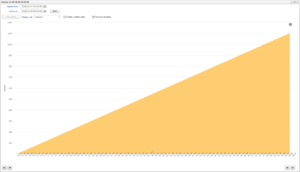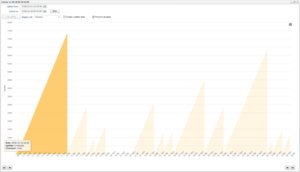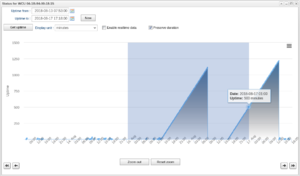Difference between revisions of "WCU Uptime"
| Line 14: | Line 14: | ||
=== Get uptime for a period of time === | === Get uptime for a period of time === | ||
Instead of stepping backwards on the time axis it is possible to display all uptime sequences for a period of time. In the Figure "WCU Uptime Interval Search" we have searched for uptime between 2018-07-01 and 2018-11-30. What is important to note is that we only show charts in their entirety. This means that when we search for a start date (e.g. 2018-07-01) the server tries to find the nearest date to this date when the WCU went alive. The found date could be exactly the provided start date but can also be as in Figure "WCU Uptime Interval Search" 2018-06-30 which is the neerest date for recorded uptime. In the case of a long uptime sequence that starts before the provided start date but stretches over and ends after the start date, this sequence may not always be visible due to the "find nearest date" mentioned above. If one is interested to see if the WCU was up at a particular date one strategy is to have this date between the start date and end date to ensure it will be included. Another strategy is to get the uptime for a period as in "WCU Uptime Interval Search" and then step backwards or forwards to even include the nearest uptime sequences that did not match the search query. | Instead of stepping backwards on the time axis it is possible to display all uptime sequences for a period of time. In the Figure "WCU Uptime Interval Search" we have searched for uptime between 2018-07-01 and 2018-11-30. What is important to note is that we only show charts in their entirety. This means that when we search for a start date (e.g. 2018-07-01) the server tries to find the nearest date to this date when the WCU went alive. The found date could be exactly the provided start date but can also be as in Figure "WCU Uptime Interval Search" 2018-06-30 which is the neerest date for recorded uptime. In the case of a long uptime sequence that starts before the provided start date but stretches over and ends after the start date, this sequence may not always be visible due to the "find nearest date" mentioned above. If one is interested to see if the WCU was up at a particular date one strategy is to have this date between the start date and end date to ensure it will be included. Another strategy is to get the uptime for a period as in "WCU Uptime Interval Search" and then step backwards or forwards to even include the nearest uptime sequences that did not match the search query. | ||
[[File:Wcu uptime3.png|thumb|WCU Uptime | [[File:Wcu uptime3.png|thumb|WCU Uptime Zoom]] | ||
=== Zoom in and zoom out === | === Zoom in and zoom out === | ||
Revision as of 16:56, 4 April 2019
The uptime of a WCU can now be tracked in minute resolution. To show the uptime for a WCU, you can either right click on the WCU in the Vehicles tab and select "WCU status" or select the WCU and then click on the "WCU status" button located in the bottom line of the Vehicles tab. The window in Figure "WCU Uptime Window" will then be visible.
When the "WCU Status" window opens it will by default show the uptime for the last seven days. If the WCU did not record any uptime during this period, the "WCU status" will look an additional seven days backwards in time until it finds an uptime sequence.
To view uptime sequences prior to the last uptime sequence, the user can step to the left on the time axis using the "left" arrow button and "fast rewind" button located in the bottom left corner of the window. Clicking the "left" button will result in stepping one uptime sequence backwards. Clicking the "fast rewind" button results in stepping 10 sequences backwards. By default when stepping backwards the number of visible uptime sequences will always be the same. In other words, if you have only one sequence visible as in Figure "WCU Uptime Window" and then clicks the "left" button this results in only showing the uptime sequence prior to current one. This can be changed by unchecking the "Preserve duration" checkbox located above the uptime chart. When having this checkbox unchecked, the result of a backward step on the time axis will result in the new uptime sequences being appended to the currently visible sequences.
Example: If only one uptime sequence is visible and we click the "left" button while having "Preserve duration" unchecked, this results in two uptime sequences after the result has been fetched from the server.
The "right" button and the "fast forward" button work the opposite way unless we are on the last uptime sequence as in Figure "WCU Uptime Window".
Get uptime for a period of time
Instead of stepping backwards on the time axis it is possible to display all uptime sequences for a period of time. In the Figure "WCU Uptime Interval Search" we have searched for uptime between 2018-07-01 and 2018-11-30. What is important to note is that we only show charts in their entirety. This means that when we search for a start date (e.g. 2018-07-01) the server tries to find the nearest date to this date when the WCU went alive. The found date could be exactly the provided start date but can also be as in Figure "WCU Uptime Interval Search" 2018-06-30 which is the neerest date for recorded uptime. In the case of a long uptime sequence that starts before the provided start date but stretches over and ends after the start date, this sequence may not always be visible due to the "find nearest date" mentioned above. If one is interested to see if the WCU was up at a particular date one strategy is to have this date between the start date and end date to ensure it will be included. Another strategy is to get the uptime for a period as in "WCU Uptime Interval Search" and then step backwards or forwards to even include the nearest uptime sequences that did not match the search query.
Zoom in and zoom out
To zoom in the chart you can simply mark the area of interest by drag-and-drop, as illustrated in Figure "WCU Uptime Zoom". This can be done several times and to trace back your step you simply press the "Zoom out"-button. If you want to completely reset your zoom, press "Reset zoom".
Real-time monitoring
The WCU status window can also be used to monitor if the WCU is currently up and running. To enable this, check "Enable realtime data" located above the main chart. When enabled, any uptime for the last 24h will be fetched and displayed. Additionally, the server will be asked for new uptime data every minute and any new data will be added to the current result. Since the WCU uploads its uptime data every 5 minutes, it can take up to 5 minutes before any results are visible in the WCU status window.
Additional features
- The display unit can be changed from minutes (default) to hours or days. If changing to hours, 160 minutes will be displayed as 02:40 (hh:mm).
- When real-time monitoring, the WCU status window can be sent to a new browser window using the little arrow located to left of the minimize-maximize buttons in the upper right corner of the window.


